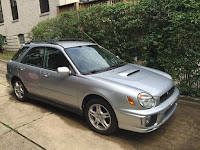Why my car cost more than taking Uber everywhere
This afternoon, I sold my car. It was a great car - a 2002 Subaru WRX with 36,700 miles. It did 0-60 in 5.9 seconds (and I'd tested it out enough times to appreciate that). Super fun. Carried groceries and anything I needed. Good for city. Good for climbing and camping trips. Worked well. Nothing wrong with it.
I'm an abnormal car owner, for sure, but one of the points I raise below (better uses of the capital expense of the car) applies pretty broadly. Over the life of the car, I paid more than $4 per mile traveled. Even if all of my travel was one-mile trips, Uber ($2 base fee + $1.25 per mile in Pittsburgh) would have been far cheaper. You can substitute Lyft or Yellow Cab for Uber in that equation, of course, assuming you could actually get a cab in Pittsburgh to pick you up when you needed.
I paid about $18,400 for it in 2005. I drove about 9200 miles. It takes premium gas. I created a little spreadsheet to let others do the same computation for themselves (or argue with me about it. grin.)
Here's the original spreadsheet on Google Docs.
In the end, my car cost more than $4.20 per mile that I drove it -- and over $38,718 over ten years, and that was with getting back more than 50% of its purchase price when I sold it and spending only $1100 on gas. I'm probably undercounting still - I'm not factoring in things like parking, but feel free to copy the spreadsheet and do the calculations for yourself!
Note that the dollars are effectively inflation-adjusted: I put in 2005 dollars, and at the end, everything's reckoned in 2015 dollars. The 7% yearly growth is a slightly conservative assumption based upon the performance of VFINX over the same period, including taking into account the expense ratio (but not taxes on any realized gains or distributions); VFINX's 10-year trailing return is about 7.8% average annual.
In the end, my car cost more than $4.20 per mile that I drove it -- and over $38,718 over ten years, and that was with getting back more than 50% of its purchase price when I sold it and spending only $1100 on gas. I'm probably undercounting still - I'm not factoring in things like parking, but feel free to copy the spreadsheet and do the calculations for yourself!
Note that the dollars are effectively inflation-adjusted: I put in 2005 dollars, and at the end, everything's reckoned in 2015 dollars. The 7% yearly growth is a slightly conservative assumption based upon the performance of VFINX over the same period, including taking into account the expense ratio (but not taxes on any realized gains or distributions); VFINX's 10-year trailing return is about 7.8% average annual.
I hope I never own a car again. For now, my wife's car is more than enough for both of us (clearly!). What an unfortunate waste of resources. No, taking public transit, uber, or cabs (or biking -- I do, after all, own a lovely bike that I love) wouldn't have been free, but it would have been better for my wallet, the environment, and likely my health. Car, you were an engineering delight, a ton of fun to drive, and you held your value surprisingly well. I'm glad you're gone, and you're not welcome back.



Comments
Post a Comment